No, The Universe Cannot Be Expanding Differently In Different Directions

It’s one way to interpret recent X-ray data, but it conflicts with much, much better data we already have.
Earlier this month, a new study came out claiming something shocking: perhaps the Universe was expanding at different rates in different directions. They looked at more than 800 clusters of galaxies that emitted X-rays, measured their temperature, brightness, and redshift, and inferred how far away they were compared to how quickly they appeared to be moving away from us.
Surprisingly, they found that one direction was consistent with a faster-than-average expansion rate while a different, not-perfectly-offset direction was consistent with a slower-than-average expansion rate, with these two directions differing from the average by about 10% apiece. Unfortunately, this interpretation is already ruled out by a much better set of observations: from the Cosmic Microwave Background (CMB), also known as the leftover glow from the Big Bang. Here’s how we know the Universe isn’t expanding differently in different directions.
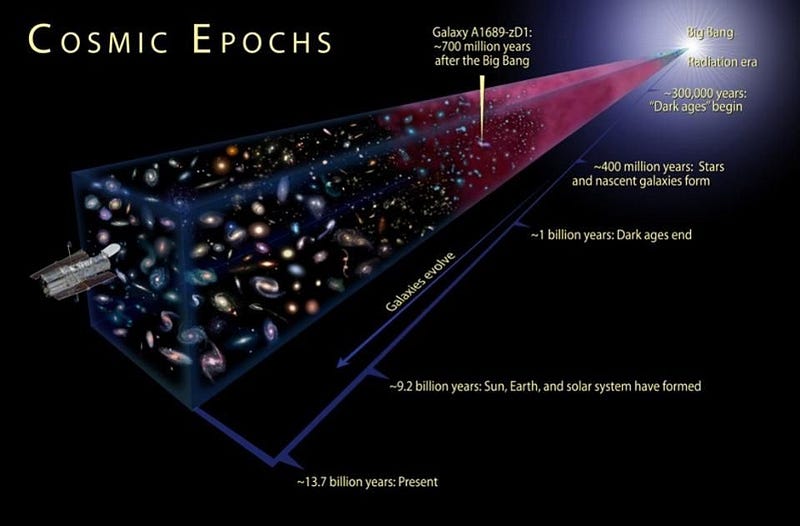
The story begins all the way back in the 1920s. Einstein’s General Relativity had just overthrown Newtonian gravity as our theory of how mass, energy, space, and time all behaved in our Universe. Not only was General Relativity able to reproduce all of Newtonian gravity’s successes, but it succeeded where Newton could not: in explaining the particulars of Mercury’s orbit. When the 1919 eclipse definitively demonstrated that Einstein (and not Newton) gave the correct predictions, the scientific revolution was complete.
But General Relativity only tells us what equations govern the Universe; they don’t tell us what conditions actually apply to the Universe. In the 1920s, various scientists worked out how the Universe would behave if it were uniformly full of matter and energy, and they derived the equations for the expanding Universe. When the critical data came in, it matched those predictions explicitly; the Universe itself was expanding.

But what that expansion meant was still open to interpretation. Many alternative explanations could explain this one observable fact; the Big Bang is the one we best know today because it fits the full suite of data so well, but this was not a foregone conclusion. The Big Bang differs from the other possible explanations by hypothesizing that the Universe is large and expanding today because it evolved from a smaller and denser past.
This idea leads to a number of remarkable predictions, including:
- a Universe where stars and galaxies first appear at a given time in the past, and clump and cluster together more severely at later times due to gravitation,
- a Universe that was hotter in the past, with shorter-wavelength light, leading to a time where the Universe first cooled to form neutral atoms,
- and an even earlier, hotter time where atomic nuclei couldn’t form, leading to a prediction for the first nuclei to form from the fusion of raw protons and neutrons.
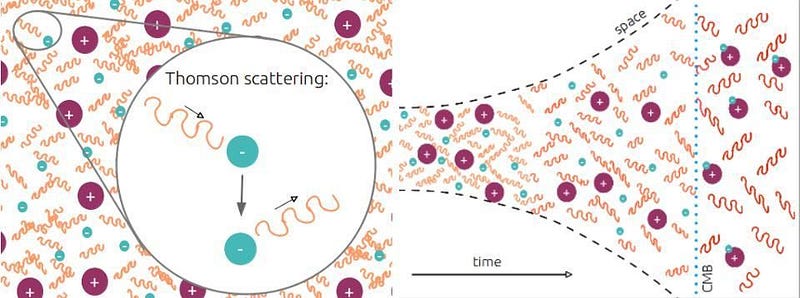
By the 1960s, a team of astrophysicists at Princeton had come up with an observational test for that second point: to measure when the Universe first formed neutral atoms. If the Universe really did have a hot, dense origin that it expanded and cooled from, then the early protons (and other atomic nuclei) would have tried to bond with the electrons that existed, but the energetic radiation from the young Universe would have blasted it apart.
Only when the Universe expands so sufficiently that there are no longer enough high-energy photons left to ionize those atoms can neutral atoms stably form: a process requiring hundreds of thousands of years. Once those neutral atoms do form, those leftover photons simply travel through the Universe, too long in wavelength to interact with those atoms. Over the billions of years since, they should redshift all the way into the microwave part of the spectrum: a cosmic microwave background (CMB). With the right equipment — a Dicke radiometer, pioneered by group leader Bob Dicke — they could finally detect it.
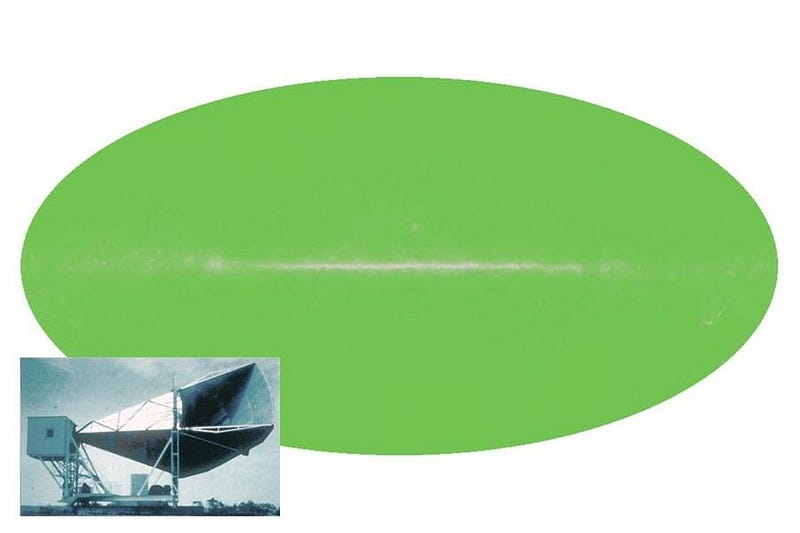
Unfortunately, they’d never get the chance. They were unceremoniously scooped by the serendipitous discovery of the CMB radiation by Arno Penzias and Bob Wilson. Using the Holmdel Horn Antenna, they found a low-energy constant “hum” of a signal everywhere in the sky, day or night. There was an excess from the Sun and the galactic plane, but that was it; other than that, the radiation was the same everywhere. After a few months, everyone put the pieces together; this was indeed the Big Bang’s leftover glow.
But this was also just the beginning of what would transform into an incredible wealth of scientific information. Encoded in the CMB is all sorts of information about the Universe. First off, the Big Bang predicts that the CMB would possess the spectrum of a perfect blackbody, with a very specific energy spectrum that observations across many different wavelengths should bear out. When the decisive data came in, this prediction was unambiguously confirmed.
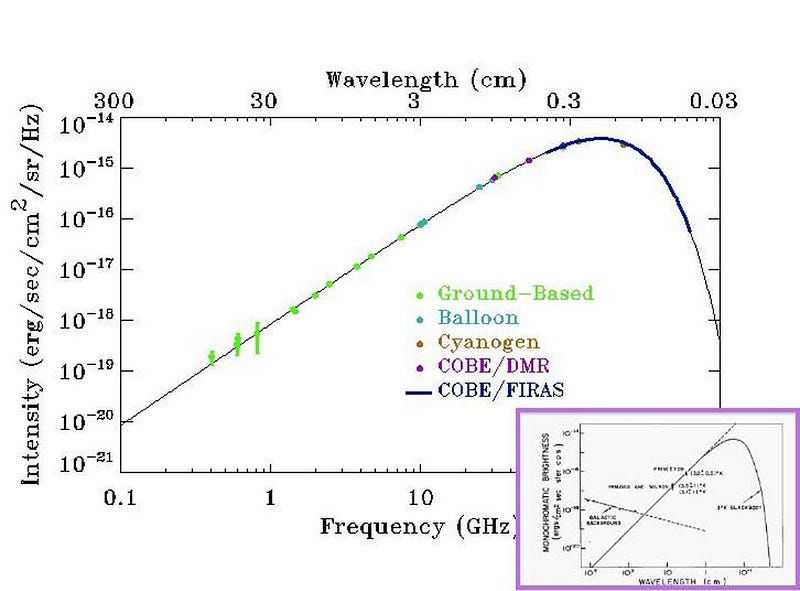
Second off, because of how the Universe clumps and clusters together, we fully expect that individual galaxies should be pulled around in random directions based on the nearby gravitational influence of the overdense and underdense regions around them. These motions have been detected for other galaxies, corresponding to scales ranging from a few hundred up to a couple of thousand kilometers per second.
But the CMB gives us a chance to measure our own motion relative to this one reference frame: we should see a “cosmic dipole” where one direction seems bluer (or hotter) and the opposing direction seems redder (or cooler). These hot-and-cold directions need to be oriented perfectly at 180 degrees to one another. In the late 1970s, this direction was detected, corresponding to a cumulative motion currently around 370 km/s, and has since been verified to spectacular precision.
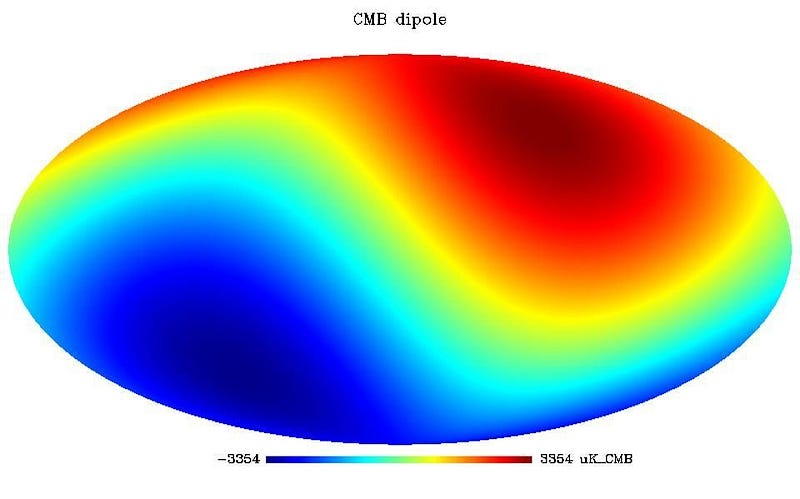
That motion creates an enormous temperature difference in the CMB: about 0.0033 K hotter in the “blue” direction and about 0.0033 K colder in the “red” direction than the average temperature of 2.725 K. It might seem a little bit dramatic to call a 1-part-in-800 temperature difference enormous, but it is when you compare it to the rest of the temperature fluctuations in the CMB: the ones that have a cosmic origin.
The Universe, as we’ve long known, could not have been born perfectly smooth. It required seed fluctuations of two varieties:
- the overdense regions, which will preferentially attract matter and grow into stars, galaxies, and the large-scale structure of the Universe,
- and the underdense regions, which will preferentially give up their matter to the surrounding, more dense regions.
It wasn’t until the 1990s that we saw these fluctuations for the first time, and they’re about a factor of ~100 weaker than the cosmic dipole.
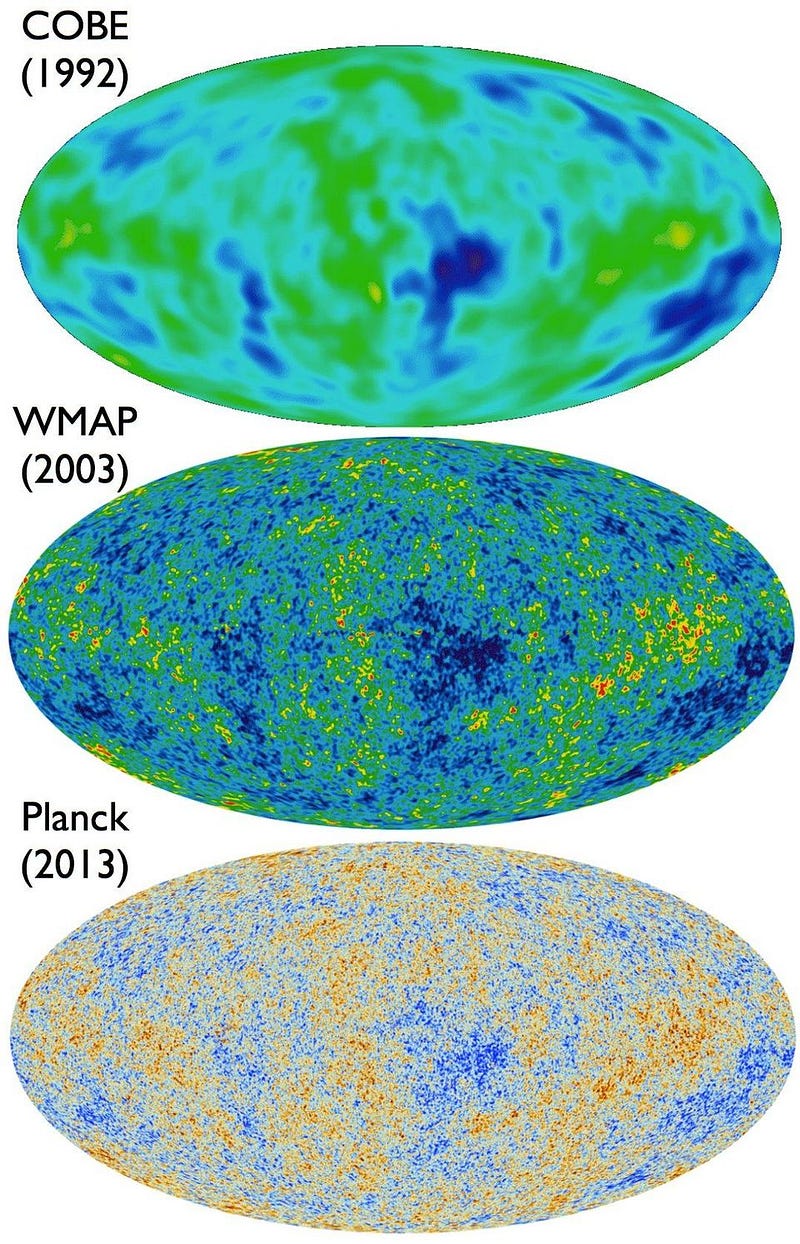
These are the temperature fluctuations that set the limits on any sort of anisotropic (i.e., different in different directions) expansion. It’s eminently possible that the Universe doesn’t expand uniformly in all directions, but the limits on how non-uniform the expansion can be is set by the strength of the temperature fluctuations we see in different directions.
If you wanted to translate the data we have from COBE, WMAP, and the Planck satellite into limits on how quickly different directions could be expanding, it corresponds to differences of around ~0.1 km/s/Mpc from the average expansion rate, a figure far more precise than our current ability to actually measure the expansion rate.
This is why the X-ray paper from earlier this month, which claimed differences of ~12 km/s/Mpc, cannot be a correct interpretation of the data.
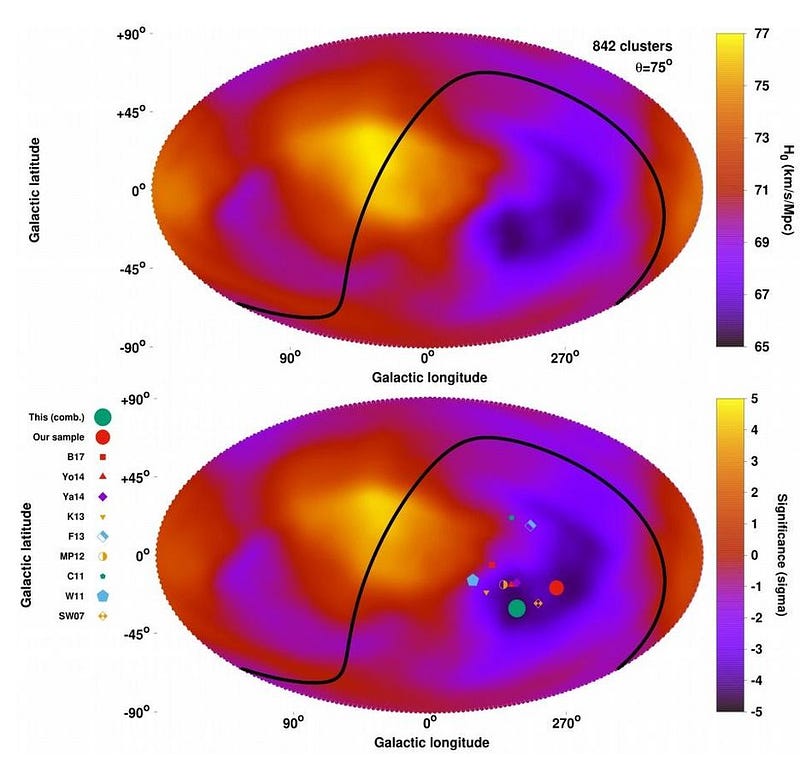
This doesn’t mean that it wasn’t a good paper, however, or that the data and the result isn’t potentially interesting. Sure, it’s possible that the method is fundamentally flawed, which is something many in the community are wary about. It’s also possible that the data is being interpreted improperly; these are the systematic errors and uncertainties that plague scientific analysis, particularly in the early stages.
But it’s also possible that there is a real effect, and we are seeing galaxy clusters behaving differently in different directions. It cannot be because the Universe is expanding differently in different directions, but it could be because there are large-scale cosmic motions that affect galaxies differently in different directions. Just as we’re moving at ~370 km/s relative to the CMB, these galaxies and galaxy clusters could be experiencing similar bulk flows that are indeed different in different directions.
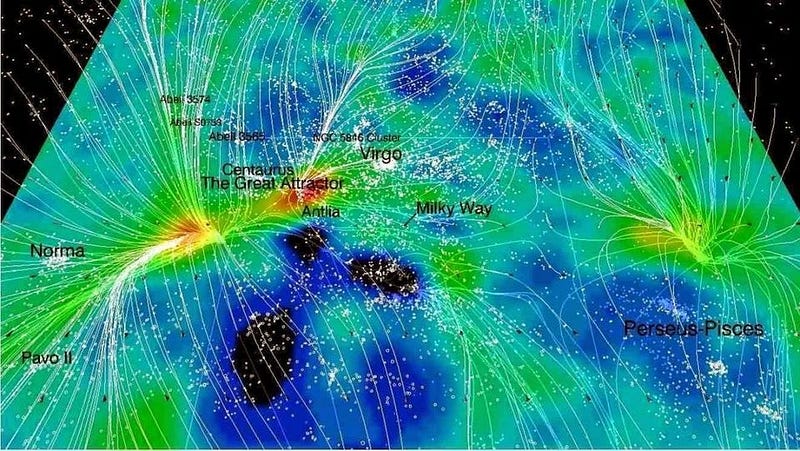
In any scientific endeavor, it’s important to reckon with whatever results your observations and experiments give you, even if they defy what you expected they’d deliver. But it’s also important to interpret your results responsibly: you cannot ignore the overwhelming suite of evidence and data — particularly when that data is even higher quality than your own — in drawing your conclusions.
In this particular case, there is some preliminary evidence that galaxy clusters may be exhibiting different properties in some directions versus others, and that’s interesting. Whether it’s because of the method used, the data taken and analyzed, or actual motions through the Universe will be a question best answered by more and better science throughout the 2020s. But it most definitely cannot be because the Universe is expanding differently in different directions. Already, for multiple decades, the evidence has been good enough to completely rule that possibility out.
Ethan Siegel is the author of Beyond the Galaxy and Treknology. You can pre-order his third book, currently in development: the Encyclopaedia Cosmologica.





